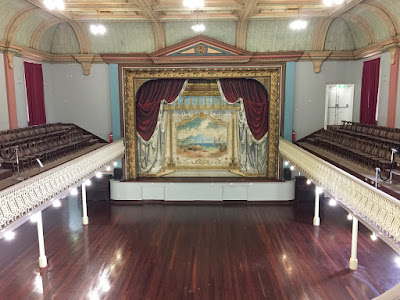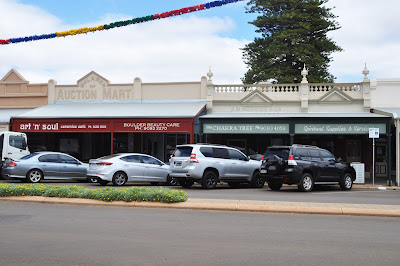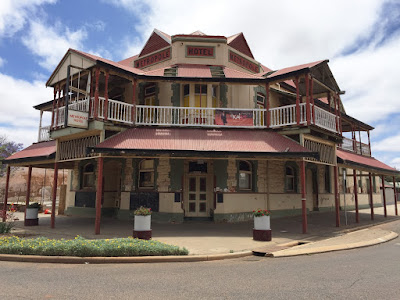DAY 136 – BOULDER AND GOLD FEVER……
This morning
we are off to do a tour of the Boulder Town Hall…
 |
| Boulder Town Hall |
 |
| Christmas Nativity Scene - Boulder Town Hall |
The Boulder
Town Hall was built in 1908 and
demonstrates the architectural style of the prosperous gold rush days. It is a beautifully preserved historical hall
with pressed tin ceilings and wrought iron balustrades.
 |
| Famous Philip Goatcher Stage Curtain in the Boulder Town Hall |
 |
| Ian enjoyed belting out a few tunes on the Town Hall piano |
 |
| A few of the ladies enjoyed dancing whilst he played |
In 1997 the
curtain was removed and transported to Sydney where it was stabilised at a cost
of $200,000 by the council and the fundraising efforts of Boulder Hidden
Secrets.
Phil W. Goatcher
(as he signed his name) was nicknamed Satin ‘n’ Velvet for the lavish illusions
he created for drop curtains that graced theatres from Paris to New York. Like
many of Goatcher’s works, the curtains painted for Perth’s His Majesty’s
Theatre were painted over in 1948.
Goatcher was paid
50 pounds in 1908 to paint the curtain as a drop canvas to complement and close
the ‘picture frame’ stage of the Town Hall. Less than a year earlier he had
painted the stage curtain at the Midland Town Hall.
 |
| Tiled foyer of the Boulder Town Hall |
 |
| Trowel that was used to lay the foundation stone of the Town Hall |
 |
| Ceiling work |
 |
| The old council chambers of the Boulder Town Hall |
 |
| Trying out the Mayoral Chair |
 |
| Photos of previous Mayors of Boulder |
 |
| Council Chambers in the Boulder Town Hall |
 |
| The last serving Mayor of Boulder - a change of letters around and you have our name... |
 |
| Stage area of the Boulder Town Hall |
 |
| A lot of history under the paint on these wall - discovered after the Earthquake in 2010. |
It was a quick trip back to the caravan park to grab our washing off the line before heading out to check out Hannan’s North Tourist Mine.
The history of
the mineshaft at Hannans North and its evolution into a tourist mine began in
the early days of Kalgoorlie’s gold rush and continues today.
In 1972, an
enthusiastic group of locals decided to open the Hainault mine to visitors. The
recently closed Hainault shaft was identified as ideal for showcasing
underground mining on Kalgoorlie’s famous Golden Mile. The Hainault shaft was
originally pegged in 1893 and was a working mine until 1968. For nearly twenty
years, in one of the most successful mines on the Eastern Goldfields, retired
Kalgoorlie miners conducted underground tours and rock drilling demonstrations
to over 750,000 visitors.
In 1991 the area where the Hainault mine was situated was incorporated into Kalgoorlie’s famous Super Pit. In recognition of the importance of showcasing mining to people visiting the area, the leaseholders, Kalgoorlie Consolidated Gold Mines (KCGM) decided to establish a new visitor attraction in the Eastern Goldfields region. In the quest to find a new site, five shafts were examined. A down-hole camera was used to probe the tunnels and workings of the shafts. Of the five shafts examined, Hannans North was in the best condition, taking into consideration that it had been dormant for many years. Given its short distance from Kalgoorlie-Boulder and its historical importance, Hannans North was chosen as the site for the new facility. Displays from the Hainault mine, historical equipment and records relating to the area’s mining activities were collected and assembled at the new site, which is now known as Hannans North Tourist Mine.
In 1991 the area where the Hainault mine was situated was incorporated into Kalgoorlie’s famous Super Pit. In recognition of the importance of showcasing mining to people visiting the area, the leaseholders, Kalgoorlie Consolidated Gold Mines (KCGM) decided to establish a new visitor attraction in the Eastern Goldfields region. In the quest to find a new site, five shafts were examined. A down-hole camera was used to probe the tunnels and workings of the shafts. Of the five shafts examined, Hannans North was in the best condition, taking into consideration that it had been dormant for many years. Given its short distance from Kalgoorlie-Boulder and its historical importance, Hannans North was chosen as the site for the new facility. Displays from the Hainault mine, historical equipment and records relating to the area’s mining activities were collected and assembled at the new site, which is now known as Hannans North Tourist Mine.
 |
| Rescue Chamber used in the mines today. |
The staff here
were very helpful and keen to make sure we enjoyed our experience, so offered
to let us come back again the following day if we kept our ticket and just
showed it upon re-entering. Bonus…. It meant
we could really take our time and read as much as we could without feeling
rushed.
The reason we had
to leave early was because of all my bad issues, I had made a chiropractors
visit for that afternoon.
After seeing the
Chiropractor we still had another 45minutes before we needed to be out at the
Superpit viewing platform for the daily explosive blast, so we decided to go
for a drive up Mt Charlotte which is the terminus of water piped
563km from Mundaring Weir in Perth to the Goldfields.
 |
| Views from Mt Charlotte Lookout overlooking Kalgoorlie |
C. Y. O’Connor was the man responsible for
this outstanding feat of water supply engineering and this project would brand
him as one of the greatest engineers of our time… In 1896, at the request of the then Premier
Sir John Forrest, C.Y. O’Connor submitted a proposal to both Houses of
Parliament for a comprehensive water scheme for the Goldfields. During the
planning and building of this grand scheme, O’Connor came under severe
criticism from the press for the foolhardiness
of the scheme. It was considered
impractical and a waste of public money. Public ridicule of the pipeline
continued unabated. The public pressure
came from those who had little understanding of the engineering concepts
involved and the necessity for such a scheme.
Some of the articles published by newspapers
of the day were extraordinarily malicious and if printed today, would be
considered libelous. O’Connor was
described as conceited, accused of corruption and the pipeline was
lampooned. He was also criticised for
upstaging his political masters.
The pipeline was pushing ever eastward. The dam at Mundaring Weir was going as
planned, but the man who was making it happen was wilting under a constant
barrage of ridicule and personal abuse.
In line with the public sentiment toward the
scheme, the Government announced a Royal Commission in 1902 into the conduct
and completion of the water scheme.
O’Connor was devastated. In May
1902, the Government enquiry found no basis for press accusation of corruption
against O’Connor.
The persistent criticism of O’Connor’s grand
vision through the press not only undermined his reputation and character, but
also affected his health. O’Connor could
accept criticism for the project… he was able to justify his engineering
capabilities, but the attack on his character caused tremendous grief.
The pressure had lasted six years and on 10th
March 1902 he took his own life. All very very sad, considering his great
talent to provide such a great engineering feat and even more so to provide it
for a cost only slightly more than his estimate made seven years earlier…..
 |
| A visit to the Super Pit in Kalgoorlie |
Then it was out
to the Superpit lookout to witness the daily explosive blast and it also gave
us a great view of a working mine in action.
The first Super Pit Lookout was a fenced area with a small viewing
platform constructed 100m south of the original Hainault Tourist Mine, near the
Boulder Block. Over the years the Lookout has been moved to accommodate the
changing pit. It is presently situated at the top of Outram Street in Boulder.
We watched blasts down in the mine and were
in awe of the way the huge trucks and equipment were miniaturized by the size
of the pit. We weren’t the only ones out
there to view the blast.
We ended the day
by going back to Hammond Park for a sausage on bread for our dinner that night,
nice and easy after a full day out sightseeing around Kalgoorlie.
Another full on
day tomorrow planned as we head out to do a tour of the “Super Pit”.


































































































































































































0 comments:
Post a Comment